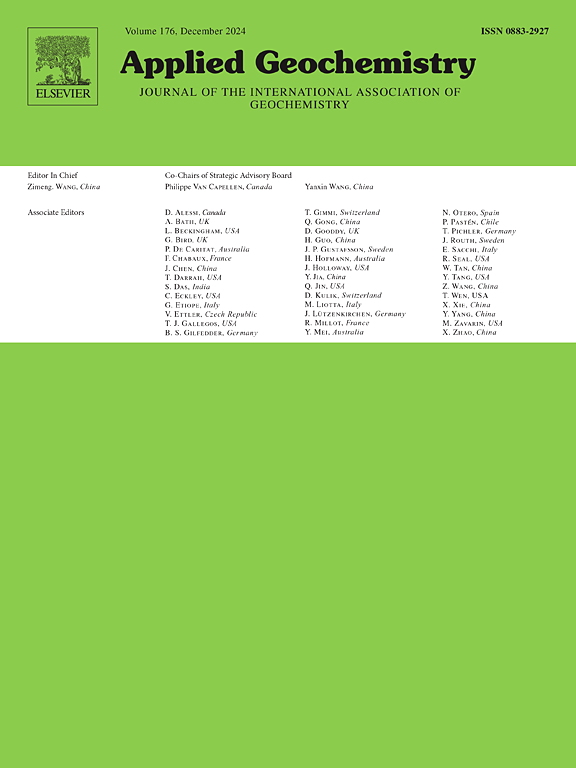Distribution of radionuclides in soils of drainage basin/cerrado biome and their relationship with the land occupation and use model
IF 3.1
3区 地球科学
Q1 GEOCHEMISTRY & GEOPHYSICS
引用次数: 0
Abstract
It is essential to know the level of radiation in the environment to develop and implement control programs to protect humans from exposure to high levels of contamination. As cerrado soils contain heavy metals and radionuclides in their composition due to agricultural activities, the objective of this study was to evaluate the concentrations and distributions of radionuclides such as potassium (40K), uranium (238U), and thorium (232Th) in the soils of the cerrado biome of the Bonito River drainage basin, and their relationship with the land occupation and use model. Gamma-ray spectrometric measurements were performed at 38 sampling points in this study. The highest three concentrations of radionuclides were detected at points 14, 16 and 32 for 238U (209.03, 221.35 and 224.28 Bq kg−1), at points 21, 20 and 32 for 232Th (133.53, 148.08 and 154.30 Bq kg−1), and at points 8, 32 and 13 for 40K (381.23, 470.75 and 698.93 Bq kg−1). In the analysis of variance at 5% probability level for the factors of rock lithology and particle size of the soils, the concentrations and distributions of the radionuclides were significant. The first component of the principal component analysis (PCA), and the basic cations calcium (Ca2+), magnesium (Mg2+) and potassium (K+) showed high correlation. It indicates the importance of cationic macronutrients in plant nutrition. The results of this study proved to be valuable for explaining and understanding the presence and distribution of 40K, 238U and 232Th in drainage basins on cerrado biomes in relation to the different natural and anthropogenic aspects of the landscape. In this sense, it was considered that clay-textured soils have higher chemical retention capacities of radioactive species. This could be useful for evaluating the radionuclide pollution in drainage basins of different regions around the world.

流域/塞拉多生物群系土壤放射性核素分布及其与土地占用利用模式的关系
了解环境中的辐射水平对于制定和实施控制方案以保护人类免受高水平污染是至关重要的。由于农业活动导致塞拉多土壤成分中含有重金属和放射性核素,本研究的目的是评价博尼托河流域塞拉多生物群落土壤中钾(40K)、铀(238U)和钍(232Th)等放射性核素的浓度和分布,以及它们与土地占用和利用模式的关系。在本研究中,伽玛射线光谱测量在38个采样点进行。238U在14、16和32点检测到的放射性核素浓度最高(209.03、221.35和224.28 Bq kg−1),232Th在21、20和32点检测到的放射性核素浓度最高(133.53、148.08和154.30 Bq kg−1),40K在8、32和13点检测到的放射性核素浓度最高(381.23、470.75和698.93 Bq kg−1)。在岩石岩性和土壤粒度因素5%概率方差分析中,放射性核素的浓度和分布具有显著性。主成分分析(PCA)第一成分与碱性阳离子钙(Ca2+)、镁(Mg2+)、钾(K+)呈高度相关。这说明了阳离子常量营养素在植物营养中的重要性。该研究结果对于解释和理解40K、238U和232Th在塞拉多流域生物群落的存在和分布与不同自然和人为景观方面的关系具有重要意义。在这个意义上,认为粘土质地的土壤具有较高的放射性物质的化学保留能力。这将有助于评价世界不同地区流域的放射性核素污染。
本文章由计算机程序翻译,如有差异,请以英文原文为准。
求助全文
约1分钟内获得全文
求助全文
来源期刊

Applied Geochemistry
地学-地球化学与地球物理
CiteScore
6.10
自引率
8.80%
发文量
272
审稿时长
65 days
期刊介绍:
Applied Geochemistry is an international journal devoted to publication of original research papers, rapid research communications and selected review papers in geochemistry and urban geochemistry which have some practical application to an aspect of human endeavour, such as the preservation of the environment, health, waste disposal and the search for resources. Papers on applications of inorganic, organic and isotope geochemistry and geochemical processes are therefore welcome provided they meet the main criterion. Spatial and temporal monitoring case studies are only of interest to our international readership if they present new ideas of broad application.
Topics covered include: (1) Environmental geochemistry (including natural and anthropogenic aspects, and protection and remediation strategies); (2) Hydrogeochemistry (surface and groundwater); (3) Medical (urban) geochemistry; (4) The search for energy resources (in particular unconventional oil and gas or emerging metal resources); (5) Energy exploitation (in particular geothermal energy and CCS); (6) Upgrading of energy and mineral resources where there is a direct geochemical application; and (7) Waste disposal, including nuclear waste disposal.
 求助内容:
求助内容: 应助结果提醒方式:
应助结果提醒方式:


